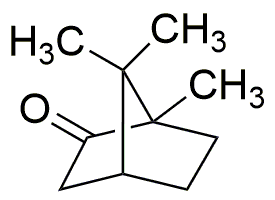(-)-Camphor is widely utilized in research focused on various practical applications across different industries. Here are five notable uses:
- Pharmaceuticals: Often used in topical analgesics and ointments, (-)-Camphor provides relief from pain and inflammation. Its cooling effect helps soothe minor aches and muscle pains, making it a staple in over-the-counter products.
- Cosmetics: This compound is a common ingredient in skincare products due to its antiseptic properties. It helps in treating acne and can be found in creams and lotions designed for oily skin, offering a natural solution for users.
- Food Industry: (-)-Camphor is used as a flavoring agent in certain food products. Its distinct aroma and taste can enhance culinary creations, particularly in Asian cuisines, where it adds a unique flavor profile.
- Aromatherapy: Known for its calming and soothing properties, (-)-Camphor is used in essential oils and diffusers. It can help alleviate stress and promote relaxation, making it popular in wellness and holistic practices.
- Industrial Applications: In the manufacturing sector, (-)-Camphor serves as a plasticizer in the production of certain plastics and resins. This enhances the flexibility and durability of materials, providing a competitive edge in product performance.
General Information
Properties
Safety and Regulations
Applications
(-)-Camphor is widely utilized in research focused on various practical applications across different industries. Here are five notable uses:
- Pharmaceuticals: Often used in topical analgesics and ointments, (-)-Camphor provides relief from pain and inflammation. Its cooling effect helps soothe minor aches and muscle pains, making it a staple in over-the-counter products.
- Cosmetics: This compound is a common ingredient in skincare products due to its antiseptic properties. It helps in treating acne and can be found in creams and lotions designed for oily skin, offering a natural solution for users.
- Food Industry: (-)-Camphor is used as a flavoring agent in certain food products. Its distinct aroma and taste can enhance culinary creations, particularly in Asian cuisines, where it adds a unique flavor profile.
- Aromatherapy: Known for its calming and soothing properties, (-)-Camphor is used in essential oils and diffusers. It can help alleviate stress and promote relaxation, making it popular in wellness and holistic practices.
- Industrial Applications: In the manufacturing sector, (-)-Camphor serves as a plasticizer in the production of certain plastics and resins. This enhances the flexibility and durability of materials, providing a competitive edge in product performance.
Documents
Safety Data Sheets (SDS)
The SDS provides comprehensive safety information on handling, storage, and disposal of the product.
Product Specification (PS)
The PS provides a comprehensive breakdown of the product’s properties, including chemical composition, physical state, purity, and storage requirements. It also details acceptable quality ranges and the product's intended applications.
Certificates of Analysis (COA)
Search for Certificates of Analysis (COA) by entering the products Lot Number. Lot and Batch Numbers can be found on a product’s label following the words ‘Lot’ or ‘Batch’.
*Catalog Number
*Lot Number
Certificates Of Origin (COO)
This COO confirms the country where the product was manufactured, and also details the materials and components used in it and whether it is derived from natural, synthetic, or other specific sources. This certificate may be required for customs, trade, and regulatory compliance.
*Catalog Number
*Lot Number
Safety Data Sheets (SDS)
The SDS provides comprehensive safety information on handling, storage, and disposal of the product.
DownloadProduct Specification (PS)
The PS provides a comprehensive breakdown of the product’s properties, including chemical composition, physical state, purity, and storage requirements. It also details acceptable quality ranges and the product's intended applications.
DownloadCertificates of Analysis (COA)
Search for Certificates of Analysis (COA) by entering the products Lot Number. Lot and Batch Numbers can be found on a product’s label following the words ‘Lot’ or ‘Batch’.
*Catalog Number
*Lot Number
Certificates Of Origin (COO)
This COO confirms the country where the product was manufactured, and also details the materials and components used in it and whether it is derived from natural, synthetic, or other specific sources. This certificate may be required for customs, trade, and regulatory compliance.


